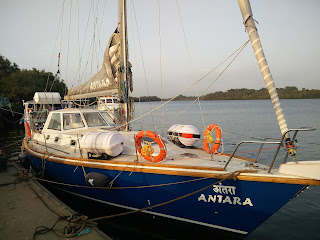Getting Equipped
 |
| Lat Long for Antara at Aquarius Shipyard |
Then we had to finalise where to locate all the equipment, on the boat. We have to ensure we make the best use of the available space, keeping in mind that there is limited space; that being a boat not all her 'walls' are flat, or straight; that she will spend all her time in water, which can be, well, wet!
The wiring was already in place and had been placed such that it was hidden from view yet easily accessible should something go wrong. The switches and electrical boxes are all placed to port, next to the galley.
The navigation table was made so that a nav chart could be easily spread out on it. Then we figured that Navionics offers electronic charts that are cheaper than the printed version. So now we have a spacious table with just the monitor and keyboard for emergency communication. The VHF set will be attached to the bulkhead just above the nav table.
The wind instruments and the MFD will be placed in the cockpit, where they will be easily visible, along with the autopilot display and switch. This enticing bunch will be aesthetically encased in a steal-proof casing.
 |
| The view from above |
The radome (radar dome) needed to be fixed on the mast, just above the first spreader. While the rest of the wiring is in the low traffic areas inside the boat, for the radome, we need the cabling work through the mast.
However, some of the ropes were stuck inside and some fair leads needed to be fixed on the mast. Which by the way, I realised the hard way, after I spent half a morning up the mast trying hard to thread the rope through. See a video of the view from the top, here. So we took down the mast and opened it up to have a look see at it's innards.
For an awe inspiring 17 metre tall chap, the mast is really just a hollow aluminum tube that houses the halyards and the wiring. And of course, is instrumental in holding that piece of cloth that catches the wind and moves the boat!
 |
| Rivets |
This is where I made my first acquaintance with rivets.Those parts that need to be taken apart easily are usually screwed on and those that must never be detached, are riveted on. They are difficult to describe but do the job in that they keep things riveted to the spot. Part of the mast had rivets and the image here shows an unused rivet and a riveted part of the mast.
Working on Antara is quite the riveting job!
With Antara, you now have the opportunity to sail, safe in Covid times - on a large sailboat, along the coast, in the deep blue yonder! You decide and we'll design a sail just for you.




Comments
Post a Comment